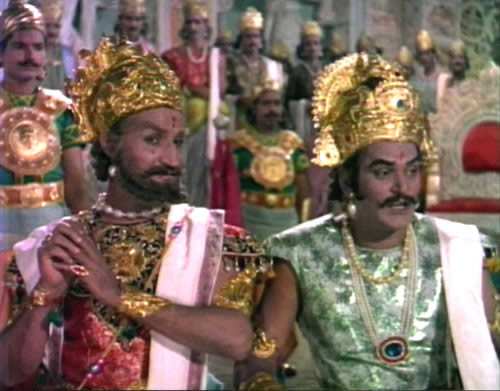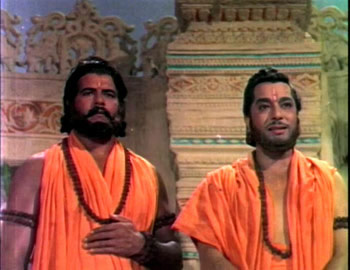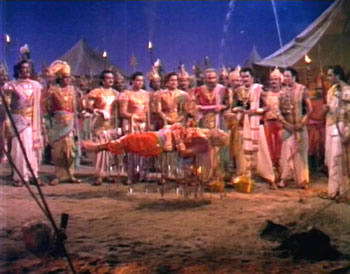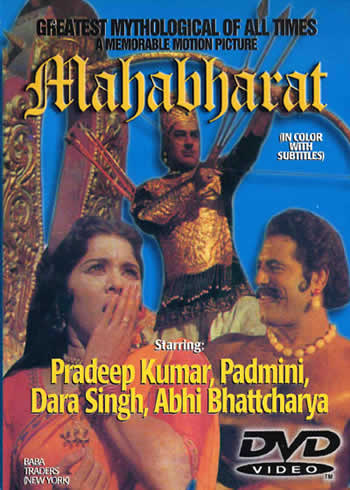
MAHABHARAT
1965, Hindi, Technicolor, 163 minutes
Directed by Babubhai Mistry (a.k.a. Mistri)
Produced by A. A. Nadiadwala
Story: Narotam Vyas, Ramnik Vaidya; Screenplay: Vishwanath Pande, Pandit Madhur; Dialogue: Pandit Madhur, C. K. Mast; Songs: Bharat Vyas; Music: Chitragupta; Special effects: Babubhai Mistry; Cinematography: Peter Parriera, Narendra Mistry
Although the earliest Indian-made feature films were based on sacred stories drawn from the copious epic and puranic literature of Sanskrit, creating a cinematic genre that would become known as “mythologicals,” this genre fared poorly in Bombay cinema after the early 1920s (though it remained strong in some other regional cinemas, especially in the South), rapidly losing ground to action-packed “stunt” and “historical” films, and later to the omnibus genre of the “social”: a melodrama with a contemporary setting and theme. After the advent of sound, only a comparatively small number of mythological films—which a Bombay director once aptly described as “stunt films that happen to be about gods”— continued to be made, generally with low budgets and catering to a niche market of pious grandmothers and rustics (e.g., JAI SANTOSHI MAA, 1975, which, however, became an unexpected hit). Occasionally, though, a major director or studio would undertake a big-budget spectacle based on the great pan-Indian epics; thus special-effects pioneer Babubhai Mistry directed SAMPOORNA RAMAYAN (“completeRamayana”) in 1961—remaking the 1936 Telugu opus that was allegedly the only film that the prudish (but Rama-loving) Mahatma Gandhi would ever consent to watch—and four years later he took on the other and darker Sanskrit epic, the fratricidal and ominous Mahabharata.

Given the infamous length and complexity of this text—100,000 couplets comprising a veritable encyclopedia of classical didactic and narrative literature—any cinematic adaptation is inevitably going to be partial and significantly condensed. In look and spirit, Mistry’s production most closely resembles a popular “Amar Chitra Katha” comic book come to life, presenting a synopsis of the epic’s core story of warring clans of cousins as a series of brief episodes, most of which are centered around tableaux that closely adhere to the conventions long established by popular visual artists—the creators of the ubiquitous and brightly-colored “god posters” of the Indian bazaar. The director assumes that his audience is already familiar with these episodes, allowing for even greater condensation; some key narrative events, indeed, are merely alluded to in passing. Sometimes badly-garbled subtitles add to the challenge that this film poses to uninitiated Anglophone viewers (see additional comments on this problem below, in the final section concerning the DVD), but those who have already been introduced to the Mahabharata story should generally be able to follow what’s going on. Though there is little in the way of original interpretation here, this brightly-tinted spectacle appears to have helped cement some of the visual and character conventions that, decades later, would be echoed B. R. Chopra’s hugely-popular (and hugely huge) 94-episode television serialization.
The film entirely skips the complex origins of the disputed succession to the throne of Hastinapura (“city of the elephant”), contested by the descendants of the half-brothers Pandu and Dhritarashtra—the Pandavas and Kauravas—and opens with the “graduation” tournament in which all these princes, schooled in weaponry by the brahman preceptor Drona, show off their skills. We see the mace-fight between the second Pandava brother Bhima (played by champion wrestler and stunt-film star Dara Singh) and his arch-enemy Duryodhana, which is ultimately interrupted by the elders when it threatens to become too violent. This is followed by the surprise challenge to the supreme archer Arjuna (Pradeep Kumar), by his near-double Karna—ostensibly a lowly charioteer’s son, though in fact the illegitimate first son of Arjuna’s own mother, Kunti, begotten by the sun god himself. After being ridiculed in the arena as a non-kshatriya (non-aristocrat and warrior, and hence an unsuitable sparring-partner for Arjuna), Karna is befriended and given a nominal kingdom by the senior Kaurava prince Duryodhana, resulting in his fateful oath of lifelong loyalty to his benefactor.

In keeping with some folk interpretations of the Mahabharata, Duryodhana is portrayed as an oafish puppet whose strings are pulled by his mama or maternal uncle, the sinister dice-master Shakuni. The latter is invariably accompanied by his son Uluk (“owl,” a bird regarded as both impure and stupid in Indian animal lore), who serves as a buffoon. Shakuni and his disciples plot the ruin of the five Pandava brothers—the rightful heirs to the Hastinapura throne—by first trying to burn them alive in a highly-combustible “Shellac Palace”—a famous episode that is here greatly compressed (the fire, set by the builder Purochana himself, occurs on the princes’ first night in Varanavata, and the tunnel through which they escape has been built without their knowledge at the command of their uncle Vidura; a wordless and momentary vignette of a peasant woman and her five sons running into the palace as a storm approaches alludes to the tribal Nishada family that is burned to death in the Pandavas’ place, confirming the false report that they have died). This quickly leads to Bhima’s encounter in the forest with a brother-sister pair ofrakshasas (monstrous but magical supernaturals who guard wild places and often devour human beings), Hidimba and Hidimbaa. The latter’s love for him occasions the film’s first song and dance sequence (Champakali chhup chhup jaye re, “flower buds are bashfully hiding”), and after Bhima dispatches Hidimbaa’s brother, mother Kunti blesses their odd union (a telling contrast to the treatment of the rakshasi Shurpanakha in the Ramayana!), which produces the giant Pandava-ally Ghatotkacha (“pot-head”—of the vessel variety). When Krishna—the Pandavas’ doting cousin and also the avatar or incarnation of god Vishnu—encounters the latter in the forest, he thus learns that his favorite cousins have survived the Varanavata inferno.

This leads to his recognition of them when, disguised as brahmans, they attend the swayamvara or marriage tournament of princess Draupadi of Panchala (Padmini), a willful and sharp-tongued lass. Following the failure of Duryodhana and other princes to hit a cleverly-contrived target with an arrow, Arjuna succeeds and wins the bride’s marriage garland. But when he brings Draupadi to his mother, the latter’s accidental remark that he and his brothers must share the “alms” they have received that day leads to the story’s famous and unorthodox polyandrous marriage. Now wed to the daughter of a powerful ally, the Pandavas return to Hastinapura to demand their share of the kingdom, and the timid Dhritarashtra consents to give them the uninhabited forest tract of Khandavaprastha, which (with Krishna’s help) the divine architect Vishvakarma (not, as in the Sanskrit text, the asuric builder Maya) soon transforms for them into a glittering new capital, Indraprastha. Here the Pandavas conduct an imperial Rajasuyasacrifice in the course of which their guest-of-honor, Krishna, decapitates King Shishupala of Cedi, after the latter repeatedly insults him. The film adds a common folk expansion on this episode: Krishna nicks his finger on the buzz-saw-like discus used to accomplish the slaying, and Draupadi hastens to tear off a strip of her sari to bandage it—an act of devoted service that (viewers know) Krishna will quickly and abundantly repay. There follows the comical episode of the “Maya Mahal” (“palace of illusions”), a sort of fun-house that Vishvakarma has thrown into the Indraprastha master-plan. When Arjuna offers his rival cousins a tour, Duryodhana is dazzled by its wonders and repeatedly embarrassed by its trompe l’oeil tricks, culminating in Draupadi’s cruel mockery of him (when he falls into a concealed pond) as “the blind son of a blind father!” Returning to Hastinapura, he vows to take revenge.


This happens during the fateful dicing match, when dharma-king Yudhishthira, unaccountably possessed by gambling fever, wagers the brothers’ wife as his final stake, and loses. The epic’s two matches are here condensed into a single game of a mere three wagers, and its shocking insults and horrific vows are somewhat sanitized (we are not told that Draupadi is menstruating, Duryodhana slaps but doesn’t bare his left thigh, and Bhima vows to rip off Duhshasana’s arm rather than to tear open his chest and drink his heart’s blood), but the film endorses the popular tradition of Draupadi vowing never to bind her hair until she can oil it with Duhshasana’s blood. Much of the scene, expectedly, is devoted to Duhshasana’s attempted disrobing of the Pandavas’ queen, and to the miracle of the endless sari, invisibly renewed from Krishna’s own hand, that protects her modesty.


The heroes’ twelve years of forest exile is encapsulated in two popular episodes: Bhima’s chastening encounter with his half-brother Hanuman in a banana grove (here, of course, minus the long discourse on cosmic time-cycles that the divine monkey delivers in the Sanskrit text); and the attempted abduction of Draupadi by Duryodhana’s wicked brother-in-law Jayadratha, which Bhima foils. The 13th year of living incognito (agyat vas, itself the subject of the Telugu classic NARTHANASALA) is similarly condensed to focus on the attempted rape of Draupadi by Kichaka, another villain who is dispatched by the ferocious Bhima. The Pandavas’ exile completed, they begin preparing for war via another pair of famous scenes: both Arjuna and Duryodhana approach Krishna for his aid, and the Pandava prince wisely chooses Krishna himself (rather than his vast army, which goes to Duryodhana), even though Krishna has stated that he will be a non-combatant. Krishna is then sent to the Kaurava court in a last ditch effort to avert battle, but his request for a mere “five villages” for his cousins is met with Duryodhana’s refusal to grant them “even as much land as can be covered by the point of a needle.”


As the armies are arrayed on the battlefield of Kurukshetra—scenes that, albeit stuffed with elephants and extras, do not compare to the awesome battle sequences in MUGHAL-E-AZAM—Arjuna receives a five-minute Bhagavad-gitaconsisting of a bland pep-talk about heroism and a quick glimpse of Krishna’s vishva-rupa (“cosmic body”) in the multi-headed form imagined by generations of poster painters. Of the eighteen-day battle itself, we see the mortal wounding of Bhishma (and Arjuna’s touching service to him as he lies impaled on multiple arrows—a staging that would be precisely repeated in Chopra’s television version), and the tragic deaths of Abhimanyu and Karna (the latter event is preceded by Kunti’s revelation to Karna that he is her son, though the Sanskrit epic places this before the war). Although there are allusions to foul play—as when Yudhishthira briefly worries about his misleading remark that led to the slaying of the brahman preceptor Drona (which is not shown)—the Pandavas’ Krishna-inspired mischief is generally downplayed, permitting the epic’s painful moral ambiguity to yield to a clearcut good guys-vs.-bad guys scenario. The agonizing aftermath of the war is elided as well, and there are no references to the later careers of the Pandavas, or to the enigmatic tour of heaven and hell with which the Sanskrit epic concludes. Instead, after Krishna cleverly foils an effort by Gandhari to make Duryodhana invincible, the sole surviving Kaurava quickly succumbs to Bhima’s club-blow to his thigh, over the illegality of which nobody unduly frets. His death immediately yields to a happy tableau of Yudhishthira enthroned among his brothers and Krishna, while a voice-over sings theGita’s redemptive promise:
For the salvation of the virtuous and the destruction of evil-doers,
for firmly establishing dharma, I come into being in age after age. (Bhagavad-gita 4:8)
This happy ending—which does a relatively greater injustice to the spirit of the Mahabharata than does, say, ending the Ramayana with the utopian vision of Ram-raj—may signal no more than the fact that Mistry ran out of time, but it also suggests the kind of upbeat nationalist closure that was thought desirable in immediate-post-Nehruvian-India: the vision of a restored and righteously-ruled kingdom healed of the trauma of territorial division and fratricidal civil war.


For those familiar with even the bare outline of the great epic (e.g., through Chakravarthi Narasimhan’s useful 200-page synopsis: Mahabharata, Columbia University Press, 1965) there is a certain charm and interest in seeing how it fares in a single-installment Bombay cinematic treatment. Music and dance, for example, are introduced through three gaudy production numbers featuring only women (the best of these, Meri chham chham payaliya tujhko pukare—“My tinkling anklets call to you”—is danced by fairies in a toy theatre in the Pandavas’ Palace of Illusions); not even Mistry, apparently, could envision a Mahabharata in which the ponderous male principals cut loose and belt out a song. Yet apart from the film’s ever-glowering Shakuni, its anxiety-ridden Kunti, and its unaccountably saucy, giggling Draupadi (Padmini’s portrayal has a certain spunk, but none of the depth of either sorrow or rage that the epic’s principal heroine displays), character and emotion here must largely be projected from the preconceptions of the viewer onto wooden actors striking heroic poses amid a succession of predictable tableaux and (now tacky-looking) special effects that cite key epic events without ever really exploring or significantly expanding on them.

[The Baba Traders DVD of MAHABHARAT is of the mediocre quality typical of this company. The Technicolor print used is occasionally scratched and faded, though generally decent and viewable. The English subtitles, however, offer more than the usual assortment of bloopers—rakshasa is translated “cannibal,” Bhishma’s boon of postponing his own death until a chosen moment is rendered as a “death-wish,” the winter solstice (when he chooses to die) is identified as the summer one, Yudhishthira’s assumed identity as the brahman “Kank” (“crane,” an allusion to the wily prey-bird) is rendered “Karn” (thus confusing him with Duryodhana’s friend), and Drona’s title of “preceptor” becomes “prelecter.” Towards the end, the subtitlist seems to have had a sort of breakdown, lapsing into Hindi verb-final word order, with the result that everyone begins to talk like Yoda. Viewers familiar with scholarly retellings should also be aware that the final short vowel “a” of many Sanskrit names, which is unpronounced in Hindi, is accordingly dropped in subtitles: hence, “Arjun,” “Bhim,” “Duryodhan,” etc.]